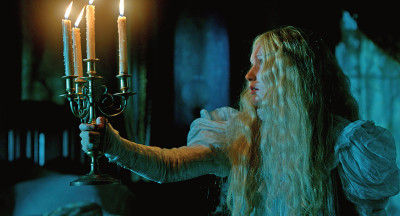
Director Guillermo del Toro has had some bad luck in terms of his upcoming projects. A few of his films — including “Pacific Rim: Maelstrom” and “Hellboy 3” — have been heavily anticipated, yet may never see the light of day due to collaborative conflicts with production studios.
What is most interesting about del Toro’s latest film “Crimson Peak,” therefore, is that it is actually much more down-to-earth than the previously mentioned films. Although it is advertised as a ghostly horror film, “Crimson Peak” is actually very much a human story.
The film tells the tale of Edith Cushing (Mia Wasikowska), an aspiring author who is haunted by the ghost of her mother. The ghost utters only one phrase to her: “Beware of Crimson Peak.” Edith has no clue what this means, and besides, she is already preoccupied with two men who fancy her.
The first is a childhood friend named Dr. Alan McMichael (Charlie Hunnam) and the second is a mysterious European inventor named Thomas Sharpe (Tom Hiddleston). Thomas is accompanied by his even more elusive sister, Lucille (Jessica Chastain). After a family tragedy, Edith marries Thomas and is whisked away to a rather strange mansion in England.
The Sharpes’ estate is run-down, to put it lightly. The walls almost literally bleed due to the red clay mines underneath the house, and there are massive gaps in the ceiling that let snow fall inside. And, the estate happens to be haunted. The bleeding walls, locked doors and crimson ghosts make for a creepy mansion shrouded in mystery, and it is the nature of that mystery that makes “Crimson Peak” really stand out.
The film’s promotion combined with the initial plot setup leads audiences to believe that the central mystery of the film has to do with the ghosts that Edith sees. While they do play a somewhat important role, the vast majority of the mystery actually comes from Thomas and Lucille. Their history and the very dynamic of their relationship lead to dark and twisted reveals that are horrific enough in their own right.
Del Toro and co-writer Matthew Robbins craft the relationship of the Sharpe siblings through many dialogue-driven scenes. Each scene dives into the psyche of each sibling — Thomas has a soft heart, while Lucille is ruthless, conniving and manipulative. Chastain gives the standout performance here, having to walk the thin line of being warmly inviting with just hint of cold-heartedness.
When the story allows Chastain to really have fun with her cruelty, the results are outstanding. The rest of the cast does a fine job, but Chastain’s screen presence is absolutely captivating. She commands every scene she is in, making her character that much more menacing. Probably by sheer talent, or perhaps her great updo, Chastain makes Lucille much more frightening than any ghost haunting her house.
The presentation of the film is absolutely gorgeous. The costumes are all gorgeously elaborate, taking the gaudy fashion standards of the 19th century and infusing them with a dark twist. Del Toro has already proven that he is a master of fantastical visuals with the classic “Pan’s Labyrinth,” and he reasserts that status by using gothic horror elements and visuals to dress his created world.
Assisted by Dan Laustsen’s cinematography, del Toro uses beautiful camera work to establish setting, create an atmosphere and to keep scares out of the frame until just before they strike. He exercises his mastery over these scenes by making otherwise horrific imagery beautiful and captivating. He does this with the bleeding walls, black moths and the like. Interestingly enough, the ghosts are the most uninspired visuals of them all.
The most disappointing part about the ghosts in “Crimson Peak” is the noticeable lack of them. Sure, there is a handful, but the few that are present are plainly designed. Their only interesting characteristic is that they are all red, the motive of which, at this point, is fairly obvious.
If the ghosts were removed and a few story elements were tweaked to make up for their absence, by and large the same story would still exist. The supernatural aspect of the film is where the horror is supposed to be derived from, but outside of some jump scares and creepy visuals, they do not advance the film in any meaningful way.
“Crimson Peak,” then, is stuck deciding whether it is a mystery driven by ghosts or by people. At its core, the film is about tragic relationships, love, jealousy and other powerful emotions. The ghosts personify these emotions, but the climax of the film makes their involvement seem disjointed. While the climax is riveting, it retroactively makes the horror aspects of the film seem almost useless.
“Crimson Peak” dips its toe into gothic horror, but refuses to take the full dive in. With a few adjustments, this film could have easily been a fantastic gothic thriller, almost in the vein of “Gone Girl.” The potential for a more focused story is present throughout, but is never explored.
At the end of the day, “Crimson Peak” is not actually about ghosts. The film itself seems to be aware of this. When Edith is asked about the ghost story she is writing, she responds, “It isn’t a ghost story, it’s just a story with ghosts in it.”
The film instead is about human emotion and tragic romantics. By the end, the viewer realizes that it was the people, not the ghosts, who were the horrific monsters all along.














